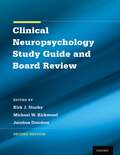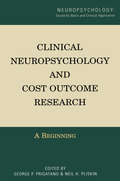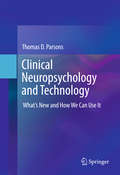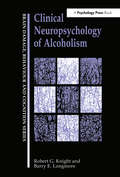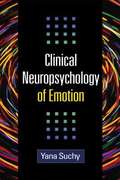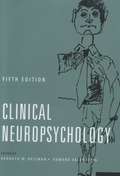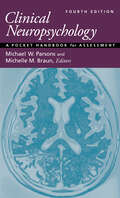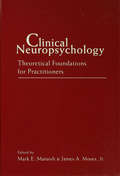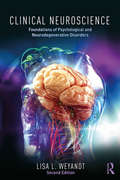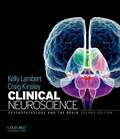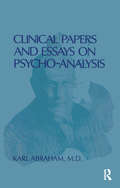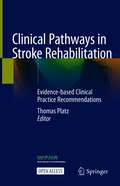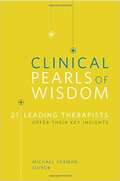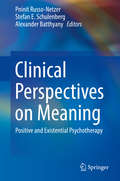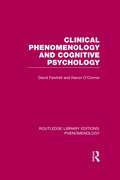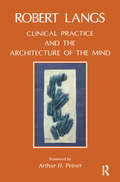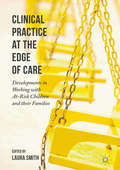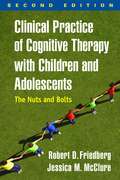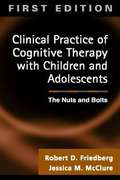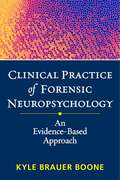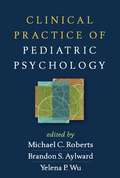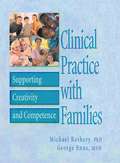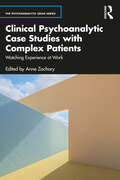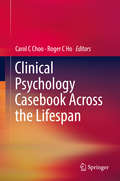- Table View
- List View
Clinical Neuropsychology Study Guide and Board Review
by Jacobus Donders Kirk J. Stucky Michael W. KirkwoodClinical Neuropsychology Study Guide and Board Review, Second Edition, provides an easy to study volume with sample questions and recommended readings that are specifically designed to help individuals prepare for the ABCN written examination. In addition, this book can be used as a teaching tool for graduate students and trainees at various levels. The book is divided into three sections: Section 1: Foundations of Clinical Neuropsychology; Section II: Fundamentals of Assessment; and Section III: Disorders and Conditions. The format is geared toward exam preparation and is much less dense than a typical textbook. Information is provided in a concise, outlined manner, with liberal use of bullets, boxes, illustrations, and tables that allow readers to easily review and integrate information into their already established knowledge base. To augment the study guide, a recommended readings list at the end of each chapter provides references to more comprehensive materials considered important or seminal in each topic area. Additionally, the book contains four 125-question mock exams designed to help readers study and prepare for the written exam. The answers to all questions are explained along with appropriate and supportive references. Features: Detailed charts and summary tables that facilitate conceptual learning Concise coverage of pediatric, adult, and geriatric issues and conditions Emphasis on critical teaching points relevant to current neuropsychological practice Mock exam questions with answers and references at the end of every chapter relevant to the content Four separate 125-question full-length mock exams with answers and references
Clinical Neuropsychology and Cost Outcome Research: A Beginning
by George P. Prigatano Neil H. PliskinNeuropsychologists are being increasingly called upon to demonstrate the value of their services. This edited book introduces clinical neuropsychologists to the concepts and challenges involved in conducting cost outcome research. It provides examples of how such research can be conducted within clinical neuropsychology and therefore is a "beginning" step in what must become an interdisciplinary effort. The text suggests that more than cost effectiveness studies should be considered when demonstrating the clinical utility of neuropsychological services. The concept of "objective" and "subjective" markers of value is emphasized, particularly as it relates to measuring the impact of a neuropsychological examination. Chapters review the economic burdens associated with different neurological conditions commonly seen by neuropsychologists. They also provide examples of how clinical neuropsychological services to different patient populations may reduce "costs" and increase "benefits" and suggest directions for beginning cost outcome research. Furthermore, the book summarizes the utility of various neuropsychological services that may be helpful to readers concerned with healthcare economies. The book is intended as a resource for clinical neuropsychologists who wish to explain to healthcare providers the value of their work. It is the first book of the National Academy of Neuropsychology book series entitled: Neuropsychology: Scientific Bases and Clinical Application.
Clinical Neuropsychology and Technology: What’s New and How We Can Use It
by Thomas D. ParsonsThis ambitious and accessible guide reviews innovative technologies enhancing the field of neuropsychological testing. Starting with the premise that standard batteries--some nearly a century old--lag behind in our era of neuroimaging, genomic studies, psychophysiology, and informatics, it presents digital measures offering more efficient administration, more accurate data, and wider clinical applications. Ecological validity and evidence-based science are key themes in these advances, from virtual environments and assessment of social cognition to the shift toward situational reliability and away from lab-created constructs. These chapters also demonstrate how high-tech assessment tools can complement or supplement traditional pencil-and-paper measures without replacing them outright. This book covers in depth: · The evolution of neuropsychological testing over the past century. · Current applications of computer-based neuropsychological assessments. · The strengths and limitations of simulation technology. · The use of teleneuropsychology in reaching remote clients. · The potential of gaming technologies in neurocognitive rehabilitation. · How technology can transform test data into information useful across specialties. Clinical Neuropsychology and Technology brings neuropsychologists, clinical psychologists, and rehabilitation specialists into the vanguard of assessment measures and processes that will translate into more accurate testing, collaborations between disciplines, and valid and useful outcomes.
Clinical Neuropsychology of Alcoholism (Brain, Behaviour and Cognition)
by Robert G Knight Barry E. LongmoreAlcohol abuse is a major health problem in most parts of the world. This book focuses on the way in which alcohol affects the brain, with the aim of describing advances in the neuropsychology of alcoholism in a way that makes this work accessible to clinicians from a variety of backgrounds who treat people with alcohol-related problems.; The book is divided into four parts. Part One provides an introduction to the medical and neurological conditions that can result from alcoholism, and to the process of neuropsychological assessment. The problems involved in conducting research in this area are also considered. In Part Two, research that focuses directly on changes to the nervous system is surveyed. This includes studies of both the short-term and the chronic neurological changes in the brain caused by alcohol. In Part Three, studies of the neuropsychological effects of acute intoxication, social drinking and alcohol abuse are described. Finally, in Part Four, the implications of neuropsychological research for the assessment and management of patients with alcohol problems are considered.The objective of this book is to collate the range of research work that is relevant to understanding how alcohol affects the brain. This includes both the acute and the chronic effects, at both the biological and physiological levels.
Clinical Neuropsychology of Emotion
by Yana SuchyWritten in an engaging, accessible style, this book synthesizes the growing body of knowledge on the neuropsychology of emotion and identifies practical clinical implications. The author unravels the processes that comprise a single emotional event, from the initial trigger through physiological and psychological responses. She also examines how patterns of emotional responses come together to motivate complex behavioral choices. Grounded in theory and research, the book discusses relevant syndromes and populations, reviews available assessment instruments, and describes how deficits in emotional processing affect cognition, daily functioning, and mental health.
Clinical Neuropsychology, Fifth Edition
by Kenneth M. Heilman Edward ValensteinNow in its Fifth Edition, Clinical Neuropsychology reviews the major neurobehavioral disorders associated with brain dysfunction and injury. Like previous editions of this book, the Fifth Edition focuses on the clinical presentation of the major neurobehavioral syndromes, including symptoms, signs, and methods of assessment that are useful for diagnosis, and also their underlying anatomy, physiology, and pathology. The major behavioral disorders that are covered include aphasia, agraphia, alexia, amnesia, apraxia, neglect, executive disorders and dementia. The text also discusses advances in assessment, diagnosis and treatment of these disorders. <p><p> The authors attempt to explain the cognitive mechanisms that can account for specific symptoms and signs, and to provide new information about treatment and management. The authors have drawn from a wealth of new information and research that has emerged since the Fourth Edition was published in 2003. The editors have added a chapter on creativity to the Fifth Edition, since there has been increased interest in creativity, and brain disorders can either enhance or impair creativity. <p> This text will be of value to clinicians, investigators, and students from a variety of disciplines, including neurology, psychology, cognitive neuroscience, psychiatry, and speech pathology.
Clinical Neuropsychology: A Pocket Handbook for Assessment
by Michael W. Parsons Michelle M. BraunFully revised and updated, this pocket handbook for clinical assessment covers a comprehensive range of neurological, neuropsychological, neuropsychiatric, and neurobehavioral syndromes and disorders. Now in its fourth edition, this ready reference helps the busy clinician or doctoral-level trainee select from among hundreds of tests and assessment techniques in clinical neuropsychology. It guides clinicians in developing tailored, hypothesis-driven approaches for assessing patients with a broad range of common neuropsychological syndromes and neurological disorders. This book is an invaluable diagnostic guide designed to fit into a lab coat pocket for accessible and immediate use. Major updates to the new edition include: A revamped approach to contemporary neuropsychological assessment that incorporates cultural factors, mood, emotion and affect, medications, cognitive functioning and electrophysiology data, as well as emerging trends including tele-neuropsychology, positive neuropsychology, and consumer‑focused reports. New and expanded coverage of topics including updates on neurodegenerative disorders and mild cognitive impairment (MCI); lifestyle interventions to maximize cognitive functioning in MCI and dementia; chronic traumatic encephalopathy (CTE), autoimmune disorders, and motor disorders. An increased emphasis on neuropsychiatric syndromes. New topics include intellectual disabilities, the impact of marijuana and alcohol on cognitive functioning, anxiety disorders/PTSD, and an expanded focus on mood disorders. Updated online resources to support teaching and learning through neuroimaging figures and video demonstrations of exam techniques, and extended reading lists that have been expanded and more fully integrated into assessment chapters.
Clinical Neuropsychology: Theoretical Foundations for Practitioners
by Mark E. Maruish James A. MosesWith the emergence of clinical neuropsychology as one of the fastest growing specialties in psychology comes the need for current and future practitioners to stay abreast of the most recent research. A number of professional journals more than adequately meet this need. But, there is also a need to stay up to date on the current thinking about important problems. Drawing upon the expertise of leaders in the field, the editors' intent in this book was to provide the practitioner with a source for discussions of topics that are vital to their ongoing development as clinical neuropsychologists but that generally are not addressed in the literature to any great degree.
Clinical Neuroscience: Foundations of Psychological and Neurodegenerative Disorders
by Lisa WeyandtClinical Neuroscience offers a comprehensive overview of the biological bases of major psychological and psychiatric disorders and provides foundational information regarding the anatomical and physiological principles of brain functioning. In addition, the book presents information concerning neuroplasticity, pharmacology, brain imaging and brain stimulation techniques, followed by chapters addressing specific psychological disorders and neurodegenerative diseases, including Major Depressive and Bipolar Disorders, Anxiety, Schizophrenia, Disorders of Childhood Origin, Addiction, as well as neurodegenerative disorders such as Parkinson’s and Alzheimer’s Disease. This highly readable textbook expands case examples and illustrations to discuss the latest research findings in clinical neuroscience from an empirical, interdisciplinary perspective.
Clinical Neuroscience: Psychopathology And The Brain
by Kelly G. Lambert Craig H. KinsleyClinical Neuroscience informs students of relevant neurobiological foundations of various mental illnesses. In this book, students will begin their journey with a tour of the brain's fundamental building blocks (neuroanatomy, neurochemistry, neurophysiology, neurodevelopment) before moving to mental health challenges and illnesses (Traumatic brain injury, Parkinson's Disease, Addiction, Schizophrenia, Obsessive-Compulsive Disorder, Depression). The final section of the book includes chapters addressing topics thought to be important for building resilience against the emergence of mental illness; these chapters cover the topics of adaptive coping strategies, hunger regulation, and the nexus between mental and immune functions. Throughout the text, the value of empirical evidence is emphasized so that meaningful progress can be made toward the identification of the most effective treatment strategies. By understanding multiple neurobiological perspectives such as neuroanatomical, behavioral, evolutionary, and neurochemical approaches currently existing in the field, students will be better prepared to conceptualize the relevant components of these mental health puzzles. Features such as opening chapter vignettes (Connections), case studies (A Case in Point) and feature boxes (Brain Matters) illuminate the course content for students as they learn about the value of translational research.
Clinical Papers and Essays on Psychoanalysis (Classics In Psychoanalysis Ser.)
by Karl AbrahamThis book is a collection of the works of Dr. Karl Abraham's writings. It covers the sexual trauma in childhood for the symptomatology of dementia praecox, the significance of intermarriage between close relatives in the psychology of the neuroses, psycho-analysis, and a study in folk-psychology.
Clinical Pathways in Stroke Rehabilitation: Evidence-based Clinical Practice Recommendations
by Thomas PlatzThis open access book focuses on practical clinical problems that are frequently encountered in stroke rehabilitation. Consequences of diseases, e.g. impairments and activity limitations, are addressed in rehabilitation with the overall goal to reduce disability and promote participation. Based on the available best external evidence, clinical pathways are described for stroke rehabilitation bridging the gap between clinical evidence and clinical decision-making. The clinical pathways answer the questions which rehabilitation treatment options are beneficial to overcome specific impairment constellations and activity limitations and are well acceptable to stroke survivors, as well as when and in which settings to provide rehabilitation over the course of recovery post stroke. Each chapter starts with a description of the clinical problem encountered. This is followed by a systematic, but concise review of the evidence (RCTs, systematic reviews and meta-analyses) that is relevant for clinical decision-making, and comments on assessment, therapy (training, technology, medication), and the use of technical aids as appropriate. Based on these summaries, clinical algorithms / pathways are provided and the main clinical-decision situations are portrayed. The book is invaluable for all neurorehabilitation team members, clinicians, nurses, and therapists in neurology, physical medicine and rehabilitation, and related fields. It is a World Federation for NeuroRehabilitation (WFNR) educational initiative, bridging the gap between the rapidly expanding clinical research in stroke rehabilitation and clinical practice across societies and continents. It can be used for both clinical decision-making for individuals and as well as clinical background knowledge for stroke rehabilitation service development initiatives.
Clinical Pearls of Wisdom: 21 Leading Therapists Offer Their Key Insights
by Michael KermanHere, for your reading and clinical pleasure, is a book that contains just these clinical "pearls" of wisdom, from the field's leading practitioners. Represented in this collection is the "take-away" message from some of the most popular conference presenters active in the field today. It covers a rich range of perspectives on the most common presenting problems: depression, trauma, anxiety, grief, couples issues, and child and adolescent difficulties. Each entry follows a similar 3-part format. First is the pearls, a brief listing of three clinical pearls based on feedback the author has received over the years from colleagues, students, book reviewers, and workshop participants. Next is the case example, a presentation of a case that best exemplifies the "pearls" in action. This section also includes an analysis by the author--why they did what they did and what they thought about it then, and now. Finally, each author provides a series of concluding remarks about the preceding material and offers readers a sense of their thinking behind their clinical work, and how this approach might be integrated into other people's client work. These innovative practices and tools will enlarge your therapeutic repertoire, and complement your existing knowledge base. Contributors:Pat Ogden, Bill O'Hanlon, and Michael Stone on depressionDusty Miller, Diana Fosha, and Babette Rothschild on traumaReid Wilson and Margaret Wehrenberg on anxietyKenneth Doka, Robert Neimeyer, and Sameet Kumar on griefSue Johnson, Carolyn Daitch, and Evan Imber-Black on working with couplesDan Hughes, Lenore Terr, and Aureen Wagner on working with childrenJanet Edgette, Martha Straus, and David Wexler on working with adolescentsDavid Wallin on the therapist's attachment patterns
Clinical Perspectives on Autobiographical Memory
by Dorthe Berntsen Watson, Lynn A. and Berntsen, Dorthe Lynn A. WatsonAutobiographical memory plays a key role in psychological well-being, and the field has been investigated from multiple perspectives for over thirty years. One large body of research has examined the basic mechanisms and characteristics of autobiographical memory during general cognition, and another body has studied what happens to it during psychological disorders, and how psychological therapies targeting memory disturbances can improve psychological well-being. This edited collection reviews and integrates current theories on autobiographical memory when viewed in a clinical perspective. It presents an overview of basic applied and clinical approaches to autobiographical memory, covering memory specificity, traumatic memories, involuntary and intrusive memories and the role of self-identity. The book discusses a wide range of psychological disorders, including depression, PTSD, borderline personality disorder and autism, and how they affect autobiographical memory. It will be of interest to students of psychology, clinicians and therapists alike.
Clinical Perspectives on Meaning: Positive and Existential Psychotherapy
by Alexander Batthyany Pninit Russo-Netzer Stefan E. Schulenberg"Clinical Perspectives on Meaning: Positive and Existential Psychotherapy . . . is an outstanding collection of new contributions that build thoughtfully on the past, while at the same time, take the uniquely human capacity for meaning-making to important new places. " - From the preface by Carol D. Ryff and Chiara Ruini This unique theory-to-practice volume presents far-reaching advances in positive and existential therapy, with emphasis on meaning-making as central to coping and resilience, growth and positive change. Innovative meaning-based strategies are presented with clients facing medical and mental health challenges such as spinal cord injury, depression, and cancer. Diverse populations and settings are considered, including substance abuse, disasters, group therapy, and at-risk youth. Contributors demonstrate the versatility and effectiveness of meaning-making interventions by addressing novel findings in this rapidly growing and promising area. By providing broad international and interdisciplinary perspectives, it enhances empirical findings and offers valuable practical insights. Such a diverse and varied examination of meaning encourages the reader to integrate his or her thoughts from both existential and positive psychology perspectives, as well as from clinical and empirical approaches, and guides the theoretical convergence to a unique point of understanding and appreciation for the value of meaning and its pursuit. Included in the coverage: #65533; The proper aim of therapy: Subjective well-being, objective goodness, or a meaningful life? #65533; Character strengths and mindfulness as core pathways to meaning in life #65533; The significance of meaning to conceptualizations of resilience and posttraumatic growth #65533; Practices of meaning-making interventions: A comprehensive matrix #65533; Working with meaning in life in chronic or life-threatening disease #65533; Strategies for cultivating purpose among adolescents in clinical settings #65533; Integrative meaning therapy: From logotherapy to existential positive interventions #65533; Multiculturalism and meaning in existential and positive psychology #65533; Nostalgia as an existential intervention: Using the past to secure meaning in the present and the future #65533; The spiritual dimension of meaning Clinical Perspectives on Meaning redefines these core healing objectives for researchers, students, caregivers, and practitioners from the fields of existential psychology, logotherapy, and positive psychology, as well as for the interested public.
Clinical Phenomenology and Cognitive Psychology (Routledge Library Editions: Phenomenology)
by Kieron O'Connor David FewtrellCognitive therapies are often biased in their assessment of clinical problems by their emphasis on the role of verbally-mediated thought in shaping our emotions, and in stressing the influence of thought upon feeling. Alternatively, a more phenomenological appraisal of psychological dysfunction suggests that emotion and thinking are complementary processes which influence each other. Cognitive psychology developed out of information-processing models, whereas phenomenological psychology is rooted in a philosophical perspective which avoids the assumptions of positivist methodology. But, despite their different origins, the two disciplines overlap and complement each other. This book, originally published in 1995, illustrates how feeling states are a crucial component of mental health problems and, if adequately differentiated, can result in a greater understanding of mental health.
Clinical Practice and the Architecture of the Mind
by Robert LangsThis book draws upon analytically oriented settings for almost all our clinical observations. It provides an excellent introduction to the theory and technique of communicative psychoanalysis and links it with the growing field of evolutionary psychoanalysis.
Clinical Practice at the Edge of Care: Developments in Working with At-Risk Children and their Families
by Laura SmithThis book brings together psychological and psychotherapeutic contributions in clinical practice with at-risk children and their families. Chapters by experts working in a range of edge-of-care settings give an essential account of real-world clinical challenges and dilemmas; whilst drawing on relevant theory and the growing evidence base for edge of care work with children and families. This title will be of interest to both clinical and social work practitioners, those commissioning and developing best practice in edge of care services, scholars and students of Clinical Psychology, Systemic Psychotherapy and related disciplines.
Clinical Practice of Cognitive Therapy with Children and Adolescents, Second Edition
by Robert D. Friedberg Jessica M. McclureWidely regarded as the definitive practitioner reference and teaching text, this book provides a complete introduction to doing cognitive-behavioral therapy (CBT) with 6- to 18-year-olds. The authors offer a blueprint for formulating cases and tailoring treatment to each child's or adolescent's unique developmental and clinical needs. Coverage includes how to orient children and families to cognitive therapy, structure each session, and implement a wide range of CBT techniques. Rich case material illustrates ways that CBT can help children struggling with specific emotional and behavioral problems. Reproducible forms and handouts can be downloaded and printed in a convenient 8 1/2" x 11" size. New to This Edition *Incorporates the latest advances in CBT with youth and gives increased attention to cultural issues, including new case examples. *Chapter on working with patients with autism spectrum disorder. *Chapter on cognitive-behavioral family therapy. *Pull-out boxes throughout that summarize key points. *Epilogue on developing clinical wisdom. See also the authors' Cognitive Therapy Techniques for Children and Adolescents: Tools for Enhancing Practice, which presents creative ways to address challenging problems.
Clinical Practice of Cognitive Therapy with Children and Adolescents: The Nuts and Bolts
by Robert D. Friedberg Jessica M. McclureTaking into account developmental issues and working with parents, this guide applies Aaron T. Beck's clinical system of cognitive therapy based on social learning theory to younger clients. Cognitive therapists Friedberg and McClure (both at Wright State U. School of Professional Psychology) present commonly used cognitive/behavioral techniques and child-friendly treatment strategies tailored to depressed, anxious, and aggressive youth. They include case examples and sample worksheets. Annotation c. Book News, Inc. , Portland, OR (booknews. com)
Clinical Practice of Forensic Neuropsychology
by Kyle Brauer BooneWritten by a foremost expert in the field, this hands-on, evidence-based guide describes how to conduct a comprehensive forensic neuropsychological evaluation and provide expert testimony. All steps are covered--from selecting, scoring, and interpreting tests to writing reports and responding to cross-examination with special attention to assessing noncredible performance. The book identifies seven common flaws of forensic neuropsychological reports and shows how to avoid them. Excerpts from testimony transcripts illustrate ways neuropsychologists can protect their reports from attack. Also featured are case illustrations and a sample report.
Clinical Practice of Pediatric Psychology
by Michael C. Roberts Yelena P. Wu Brandon S. AylwardFilled with vivid clinical material, this book describes effective practices for helping children and their families who are coping with chronic and acute health conditions and their treatment. Concise chapters on the psychosocial challenges associated with specific pediatric health conditions are organized around detailed case presentations. Demonstrating procedures for assessment, case conceptualization, brief intervention, and health promotion, the book highlights ways to collaborate successfully with medical providers and families. Chapters also discuss the varied roles that pediatric psychologists play in hospitals, outpatient clinics, primary care, and educational settings. See also Handbook of Pediatric Psychology, Fourth Edition, edited by Michael C. Roberts and Ric G. Steele, which comprehensively examines links between psychological and medical issues from infancy through adolescence.
Clinical Practice with Families: Supporting Creativity and Competence
by Michael Rothery George EnnsEncourage creative change in troubled families!Clinical Practice with Families: Supporting Creativity and Competence presents the most important and useful contemporary ideas in family therapy from many diverse traditions. By organizing eclectic concepts within one basic, powerful framework, it makes these ideas more accessible and effective in practice.Instead of exploring these ideas in the abstract, Clinical Practice with Families illustrates them with in-depth case examples that include detailed studies of the client family's history and traditions, extensive analyses of the family system, and actual dialogue from sessions, along with the therapist's comments on shifting alliances and other unspoken occurrences. No other technique could better demonstrate the practical integration of therapeutic skills and concepts to meet the clients’needs.Clinical Practice with Families offers insight and ideas for practicing family therapists in such essential areas as: negotiating flexible, appropriate boundaries between family members and between yourself and your clients constructing ecomaps of a client's support systems and stressors identifying four kinds of supports helping the client reinterpret family traditions enabling clients to break the pattern of old narratives encouraging clients to set realistic, achievable goalsClinical Practice with Families offers a powerful set of techniques and ideas in a clear, understandable framework. Illustrated with helpful charts and figures, it offers senior students and practicing family therapists an opportunity to take a structured approach to contemporary theory and understand its implications for practice.
Clinical Psychoanalytic Case Studies with Complex Patients: Watching Experience at Work (The\psychoanalytic Ideas Ser.)
by Anne ZacharyClinical Psychoanalytic Case Studies with Complex Patients is a collection of key case studies that provides a rich resource of information and inspiration for clinicians working psychoanalytically with complex and disturbed patients in a range of contexts. The book is presented in six parts, each introduced with commentary that puts the material into context. It covers a range of topics including autism, violence and perversion, psychosomatics, hysteria, dementia, psychosis and assessment of gender dysphoria. Each chapter presents either a single case study or a selection of case vignettes, examines necessary context and presents additional detail about subsequent treatment. The depth and range of the cases presented provide key insight into and detailed consideration of risk assessment, safe settings and other important preliminary issues. Clinical Psychoanalytic Case Studies with Complex Patients will be of great interest to psychoanalysts in practice and in training, psychoanalytic psychotherapists and other clinicians seeking an introduction to psychoanalytic work.
Clinical Psychology Casebook Across the Lifespan
by Carol C Choo Roger C HoThis book illustrates the multifaceted applications of clinical psychology in multi-cultural contexts. It considers people’s emotional, cognitive, interpersonal and psychological development across their lifespans. The book explores nine multicultural clinical cases that illustrate clinical assessment, biopsychosocial formulation, and evidence-based therapy. Further, it provides therapy outcomes for diverse clients throughout their lifespans, e.g. for cognitive behavioral therapy, integrative therapy, and narrative therapy; and examines clinical findings on e.g. social and emotional development, family trauma, child sexual abuse and its impact, as well as culturally sensitive assessment and interventions for a range of mental health issues. Further cases focus on co-morbid conditions, and physical ailments, across the lifespan.Bringing together contributions from both academics and practitioners, the book illustrates practical applications of theories and concepts relevant to the practice of clinical psychology. It also reviews the relevant literature with clinical recommendations, and provides multicultural perspectives and insights into contemporary clinical approaches from experienced clinical supervisors and practitioners, who are also academics and educators in the field. Accordingly, the book offers a valuable asset for students, academics, researchers and practitioners, as well as for postgraduate clinical training.
